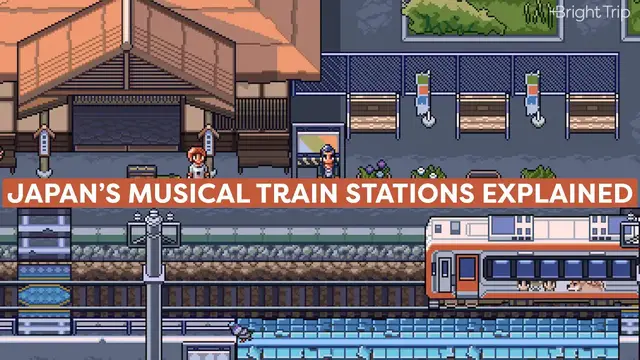Japan’s train stations have something called “train departure melodies”. These melodies are each 7-seconds long and were created to help commuters and train conductors know when the doors of the train are about to close. There are HUNDREDS of train departure melodies for different stations, lines, and for each direction that the train is going. There is actually one man behind many of the jingles, his name is Minaru Mukaiya.
Show More Show Less View Video Transcript
0:00
If you find yourself in a train station in Tokyo, you might notice something pretty unique when you're there
0:12
And no, it's not the train pushers. It's actually something you'll hear. Something like this
0:20
This melody is actually called Haseya Merouji, or a train departure melody
0:31
And almost every train station in Japan has its own unique song
0:46
And there's just so many jingles, but why? Leading up to the 1970s, the daily routine of a typical Tokyo train station during rush hour
0:56
consisted of jam-packed trains, platforms flooded with people, and very little time to transfer from
1:02
one train to another. And this left communers with very little margin for error. And you had to be
1:09
fast. And to add to all of this, a loud buzzer would sound off as the train doors were about to
1:15
clothes. This, along with station attendance whistles, announcements, salarymen racing downstairs and across platforms, caused things to sound a little bit, dare I say, chaotic
1:28
Then, in August of 1971, train departure melodies were developed as an initiative by a private
1:35
railway, Keon Electric Railway, that runs between Kyoto and Osaka. And they found that these little
1:41
tunes actually created some serenity to a authorized, very stressful audio environment
1:47
So much so that in 1989, major railway operator J.R. East commissioned Yamaha and composer
1:53
Hiroaki Ide to create departure melodies and the jingle started spreading across the country
2:03
So these songs are capped at seven seconds. 7 seconds allows for what is called the perfect amount of dwell time
2:17
The amount of time train operators have to cram people into packed commuter trains and
2:22
still famously have these trains run perfectly on time. The jingles didn't just provide a nice ambiance, but they also gave riders a way to know when
2:31
the doors were about to close and how much time they had. We all know what it feels like to not know when or if the doors are going to close as
2:48
we're rushing towards a train. Harry Potter should have gone back home when he missed the train
2:52
So needless to say, these jingles were a good thing. Today while there still are some stations that still use the standard buzzer
3:01
Hundreds of train lines in Japan are provided with metro jingles. and there's actually one man behind many of the jingles that you may hear
3:30
this is Munaru Mikaya he has composed jingles for more than 110 stations and has made over 200
3:38
melodies. Great Big Story actually did a really incredible video on Mr. Mukaya and his whole
3:46
process of creating these jingles. So if you're interested in learning more about that, I
3:51
definitely recommend you guys check it out. I'm going to link the video in the description
3:58
And he's overall just kind of the coolest dude ever. he played the synthesizer for a really popular jazz fusion band called cassiopeia in the 80s
4:08
and this man has two loves trains and music he actually built a company that developed a train
4:18
video game called train simulator and it was so realistic that train companies asked him to
4:23
design something similar for train operators to learn on hello everybody editing jordy here
4:30
from the future hence why I look much more disheveled. I actually found something pretty
4:36
cool while I was editing this video so I wanted to pop in here and explain it a little bit because
4:41
I think you guys will find it pretty fun and exciting. So Mr. Mukaya's company, Angakukan
4:48
has created dozens of Train Simulator video games. So Train Simulator is actually a series
4:54
of video games that Angakukan publishes and develops and one of the most popular games
5:00
in this series is called Densha De Go and it was actually a plug-and-play video game in 1996
5:07
So then in 2010, they did a little bit of a revision of Densha De Go for the Nintendo DS
5:13
and then even more recently, like really recently, they created a Densha De Go for the PlayStation 4
5:22
and Nintendo Switch. Now, as an owner of the Nintendo Switch, I knew I needed to play this
5:27
game for this video for research purposes, not for my own entertainment at all. Unfortunately
5:34
the game is only available in Japan right now. But there is a bright side to this because the
5:41
original Denshide Go is actually available to play on your phone. So we're going to do that
5:47
I'm going to leave a link in the description where you can play the game. It is in Japanese
5:52
I can't read Japanese, so I looked up a little tutorial, but I still don't really know what I'm
5:56
doing. I wonder if this game plays the train departure melodies because it's Mr. Makai's company
6:12
Okay, there we go. And we're off. I don't know what I'm doing. I think that the objective of
6:18
the game is to have your train stop perfectly. I don't know how to stop the train, so we're gonna
6:25
do our best here I don know how long this route is either Like is there gonna be an announcement or something Oh wait there a countdown Got an exclamation point Oh god Oh god this isn good
6:37
Okay, I'm scared. I'm gonna... I don't want to crash it. Do I press the right button
6:44
Uh, good! Hey! I got a good! Okay, so that was a little playthrough of Den Today Go
6:52
Mr. Mukaya is just the icon of train entertainment, music, and video games
6:58
Okay, let's go back to the real video where I look like a human being
7:03
After making these connections in the train world, he was actually given the opportunity to be the new composer for train departure melodies after Hideki Ide had retired in the early 2000s
7:15
And he's kind of a huge deal. He plays his train melodies at concerts
7:22
And impressively, he has over 34,000 Twitter followers and has garnered a cult following
7:28
Like, seriously, he's banned from playing at Ginza Station because one of his concerts caused extreme pandemonium
7:35
Despite the seven short seconds of each melody, Mr. Mukaya explains that each one packs in a story
7:41
And I'd honestly argue that Mr. Mukaya's process of creating these jingles is just as captivating as the jingles themselves
7:48
Let me explain. When composing a song, he visits the station and looks at the way the train enters and the way it leaves
8:01
He also looks into the demographics and history of the neighborhood that the station is located in
8:07
So for neighborhoods with an older population, he makes melodies with more traditional Japanese instruments
8:13
And for neighborhoods with students, he makes melodies he knows younger people will favor
8:19
And in Japan's ancient capital, Kyoto, he explains the station's song saying
8:26
we have a deep respect for culture, so the song sounds more respectful of Japanese culture
8:34
The crescendo and rising pitch in Shibuya Station's departure song, on the other hand
8:39
is a nod to the train's uphill journey to the next platform. And the station at Takada no Baba, the home to the very popular anime series Astro Boy
8:54
pays homage to the cartoon with a jingle version of the show's theme song
9:05
And there is just so much that Mr. Mukaya puts into composing these jingles
9:10
and to add on top of it, each melody in a train's line creates one longer song that flows seamlessly together
9:17
and he creates each piece with what he describes as human groove. Music played
9:24
by hand, not generated by a computer. So it's not too perfect. So many tourists
9:30
including myself, typically really enjoy hearing the jingles in the train stations. But I wondered if the locals who had to make a commute every day and
9:41
had to listen to the same melodies all the time maybe weren so keen on it So I searched through some reviews and generally these jingles are pretty well received
9:56
However I did read that some residents living near open-air rail stations were
10:01
more wary of hearing these same jingles on repeat all day and had complained
10:07
about noise pollution. But despite some disagreement I think it's pretty fair to
10:11
to say that locals don't mind the jingles and some of them actually love them
10:21
In Japan, train fanatics, or densha utaku, actually travel across the country to record
10:27
these melodies and post them on the internet. And write entire blogs devoted to cataloging them
10:36
And if you have taken a liking to these jingles, you can buy a CD with different
10:40
station's melodies, keychains that play the music from your favorite station, or an alarm clock that
10:46
lets you wake up to the melodies from an entire train line. Apparently the alarm clock sold over
10:54
2,000 units priced at 58,000 yen, which is a little over 50 US dollars in under a month
11:02
And I kind of want one. So these train departure melodies are a really creative way to keep things
11:07
efficient, organized, and less chaotic in Japanese train stations. I don't know if the popularity of the jingles was expected by train companies
11:16
but I think it's fair to say that Mr. Mukaya has made a huge contribution to people's love for these jingles
11:29
Thank you guys so much for watching. If you guys are interested in learning more about Tokyo
11:33
we actually have an entire course called Tokyo Demystified, where we go over food, religion, shopping, transportation
11:40
And not only will you learn so much about traveling in Tokyo
11:44
and the history behind it, but it's also just beautiful. This course is just visually stunning
11:54
So if you want to travel smarter when you go to Tokyo, I suggest going to brighttrip.com slash Tokyo
12:00
and you can take the course and it's a lot of fun. And I will see you guys next time
12:05
Bye. So I actually have a little funny story here. While I was traveling abroad in Japan, I loved
12:15
the train departure melodies, but my friends and I also noticed something kind of odd when
12:20
we were at train stations late at night. We would hear this really high-pitched tone and
12:23
we would ask our professor, do you hear that? Like, what is that? And he'd be like, I don't
12:27
know what you're talking about. And we were like, what? While researching this video, I
12:31
actually found out that the train stations have this sort of fear of young people loitering
12:36
late at night. So some train stations actually deploy these ultrasonic deterrents, which are
12:42
these small little devices that play this really high frequency tone. And the particular frequency
12:47
that these stations use is 17 kilohertz. And apparently it can only be heard by those under
12:54
the age of 25. So it's no wonder that Japanese train stations are considered the most efficient
12:59
and reliable. They're keeping the young people out
#Tourist Destinations
#Other



